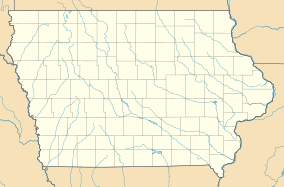Pillsbury Point State Park facts for kids
Quick facts for kids Pillsbury Point State Park |
|
|---|---|

Sign at the park's entrance
|
|
| Location | Dickinson, Iowa, United States |
| Area | 6.48 acres (2.62 ha) |
| Elevation | 1,424 ft (434 m) |
| Established | 1933 |
| Governing body | Iowa Department of Natural Resources |
Pillsbury Point State Park is a special place in Arnolds Park, Iowa, United States. It's Iowa's smallest state park, and it's unique because it's right in a town, not out in the countryside. This narrow park, about 6.48 acres (2.62 ha) big, stretches out like a finger of land into West Okoboji Lake. It's a historic spot, with parts of it, like the overlook at the north end, listed on the National Register of Historic Places since 1990. This historic area includes cool stone walkways, steps, benches, and old boundary markers.
Contents
Park History and Development
Early History and Naming
The area where Pillsbury Point State Park now stands has a significant past. In 1857, a sad event known as the Spirit Lake Massacre happened nearby. During this time, some settlers were killed, and four women were taken hostage by members of the Dakota tribe. Graves for several victims, a monument from 1895, and the historic Gardner cabin are located next to the park.
The park is named after Rev. Samuel Pillsbury, who owned this land in the 1860s. Later, in the 1890s, H.H. Lantz turned the property into a fun recreation area. His widow, Florence B. Lantz, and two other family members, Miriam L. and John I. Cross, generously gave the land to the state of Iowa in 1928.
Building with the Civilian Conservation Corps
Between October 1933 and March 1934, a group called the Civilian Conservation Corps (CCC) Company 778 worked on the park. The CCC was a program during the Great Depression that put young men to work on conservation projects. They built the lovely walkways along the lake, two sets of stone steps, and five stone benches that you can still see today.
Changes in Park Status
In 1934, Pillsbury Point was changed to a state preserve. Preserves are meant to protect areas of historic or scientific interest, rather than just for recreation. In 1936, it was managed by Gull Point State Park. Then, in 1940, it was reclassified again as a historic-archaeological park, following a system used by the National Park Service. By the end of the 20th century, the park became well-known as a public access point to the lake.
The Historic Overlook and Stone Features
The overlook area of Pillsbury Point is important because of how it was designed. It shows a special way of developing parks that was popular in the 1930s. This park is mostly about its landscape, as there are no buildings here.
The stone benches built by the CCC are carefully placed into the slopes along the shore. This way, they don't spoil the natural beauty of the area. Four of the benches have stone backs and seats made of mortared rubble stone, with a stone base in front. The fifth bench is also made of mortared rubble stone, but it's shaped like a "U" and doesn't have a base in front. The two sets of steps are also made from the same mortared rubble stone.
You can also find six concrete markers that show the property line on the south side of the overlook. There are twelve more markers that show the park's full boundary, but these are outside the main historic area.
Images for kids



